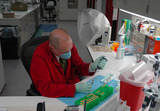
This is a Introduction to microbiology course. The content of this module is syllabus as well as powerpoint slides presentation, using OpenStax Microbiology textbook. Content uploaded by Joanna Gray. All content created by Jaleh E. Jalili

This is a Introduction to microbiology course. The content of this module is syllabus as well as powerpoint slides presentation, using OpenStax Microbiology textbook. Content uploaded by Joanna Gray. All content created by Jaleh E. Jalili

Biology is designed for multi-semester biology courses for science majors. It is grounded on an evolutionary basis and includes exciting features that highlight careers in the biological sciences and everyday applications of the concepts at hand. To meet the needs of today’s instructors and students, some content has been strategically condensed while maintaining the overall scope and coverage of traditional texts for this course. Instructors can customize the book, adapting it to the approach that works best in their classroom. Biology also includes an innovative art program that incorporates critical thinking and clicker questions to help students understand—and apply—key concepts.



By the end of this section, you will be able to:Identify and describe the properties of lifeDescribe the levels of organization among living thingsRecognize and interpret a phylogenetic treeList examples of different sub disciplines in biology

By the end of this section, you will be able to:Identify and describe the properties of lifeDescribe the levels of organization among living thingsRecognize and interpret a phylogenetic treeList examples of different sub disciplines in biology

In this lesson, the students look at the components of cells and their functions. The lesson focuses on the difference between prokaryotic and eukaryotic cells. Each part of the cell performs a specific function that is vital for the cell's survival. Bacteria are single-celled organisms that are very important to engineers. Engineers can use bacteria to break down toxic materials in a process called bioremediation, and they can also kill or disable harmful bacteria through disinfection.

In this unit, students look at the components of cells and their functions and discover the controversy behind stem cell research. The first lesson focuses on the difference between prokaryotic and eukaryotic cells. In the second lesson, students learn about the basics of cellular respiration. They also learn about the application of cellular respiration to engineering and bioremediation. The third lesson continues students' education on cells in the human body and how (and why) engineers are involved in the research of stem cell behavior.